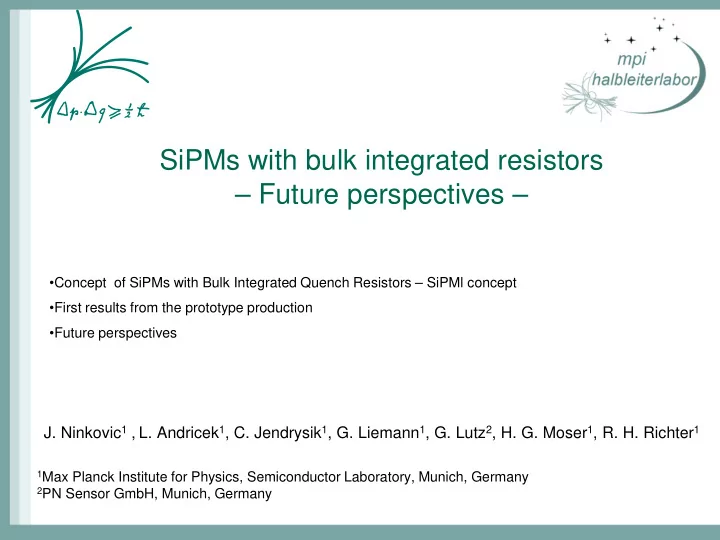

SiPMs with bulk integrated resistors – Future perspectives – •Concept of SiPMs with Bulk Integrated Quench Resistors – SiPMl concept •First results from the prototype production •Future perspectives J. Ninkovic 1 , L. Andricek 1 , C. Jendrysik 1 , G. Liemann 1 , G. Lutz 2 , H. G. Moser 1 , R. H. Richter 1 1 Max Planck Institute for Physics, Semiconductor Laboratory, Munich, Germany 2 PN Sensor GmbH, Munich, Germany
SiPM cell components SiMPl approach high field p + n n - AD C D depleted gap region n - n - non-depleted non-depleted R Q C C region region n + anodes V bias p + <<450 µ m n + V bias resistors Jelena Ninkovic 2 TIPP 2011, Chicago, IL
SOI wafers sensor wafer sensor wafer handle wafer handle wafer 1. implant backside 1. implant backside 2. bond sensor wafer 2. bond sensor wafer 3. thin sensor side 3. thin sensor side 4. process SiMPl arrays on sensor wafer on sensor wafer to handle wafer to handle wafer to desired thickness to desired thickness on top side on top side HLL Industrial partner Sensor wafer Handle wafer Jelena Ninkovic 3 TIPP 2011, Chicago, IL
Advantages and Disadvantages Advantages: • no need of polysilicon • free entrance window for light, no metal necessary within the array • coarse lithographic level • simple technology • inherent diffusion barrier against minorities in the bulk -> less optical cross talk Drawbacks: • required depth for vertical resistors does not match wafer thickness • wafer bonding is necessary for big pixel sizes • significant changes of cell size requires change of the material • vertical ‘resistor‘ is a JFET -> parabolic IV -> longer recovery times Jelena Ninkovic 4 TIPP 2011, Chicago, IL
Prototype production >130 different chips 30x30 array 6mm sensitive area free 6mm Jelena Ninkovic 5 TIPP 2011, Chicago, IL
Results Static measurements Dynamic measurements High homogeneity over big distances! High homogeneity within the array! 6 (10x10) arrays placed over 6mm distance Jelena Ninkovic 6 TIPP 2011, Chicago, IL
Gain linearity 10x10 array of 130 µ m pitch @ -30°C Jelena Ninkovic 7 TIPP 2011, Chicago, IL
Dark rate Due to the non optimal process sequence of the high field processing ~10MHz @300K for 4V overbias 10x10array of 130 µ m pitch Normal operation up to 4.5V overbias @227K Jelena Ninkovic 8 TIPP 2011, Chicago, IL
Fill factor & Cross Talk & Photon Detection Efficiency Produced SiMPl devices have the world record in the fill factors! Pitch / Gap Fill factor Cross talk PDE calc. PDE calc. ( ∆ V=2V) ( ∆ V=5V) meas. ( ∆ V=2V) 130 µ m / 10 µ m 85.2% 29% 39% 61% 130 µ m / 11 µ m 83.8% 27% 38% 60% 130 µ m / 12 µ m 82.4% 25% 37% 59% 130 µ m / 20 µ m 71.6% 15% 32% 52% PDE estimate: •Optical entrance window: 90% @400nm •Geiger efficiency : 50% @ 2V overbias 80% @5V overbias 9
Fill factor & Cross Talk Produced SiMPl devices have the world record in the fill factors and still lower cross talk! Hamamatsu MPPC ∆ V=2V No special cross talk SiMPL suppression technology applied just intrinsic property of SiMPl devices ∆ V=2V ∆ V=1V ∆ V=1V Jelena Ninkovic 10 TIPP 2011, Chicago, IL
Detection of particles Excellent time stamping due to the fast avalanche process (<1ns) MIP gives about 80pairs/ µ m huge signal in SiPM allows operation at small ∆ V @223K 10% GE still gives >98% MIP detection Reduction of dark rate and cross talk by order of magnitude Jelena Ninkovic 11 TIPP 2011, Chicago, IL
Detection of particles Dark rate: 1 MHz/mm² = 1 hit/µm²/s = O(Belle II) With 20 µm pitch and 12 ns time stamp: occupancy: 2.5 x10 -6 Power (analogue): ~ 5 µW/cm² Dominated by dark rate Possible problems: •Radiation hardness (dark rate increases due to bulk damage) •Cross talk •Efficiency (fill factor) •Digital power Jelena Ninkovic 12 TIPP 2011, Chicago, IL
Next generation SiMPl devices TDC, Photon counter, active recharge Topologically flat surface Cell Cell electronics electronics High fill factor n Adjustable resistor value n - Pitch limited by the bump bonding depleted gap region n - n - non-depleted non-depleted region region n + Jelena Ninkovic 13 TIPP 2011, Chicago, IL
Next generation SiMPl devices n Topologically flat and free surface n - High fill factor depleted gap region Sensitive to light n - n - non-depleted non-depleted region region n + Cell Cell electronics electronics TDC, Photon counter, active recharge sensor wafer sensor wafer handle wafer handle wafer 1. Structured implant on backside 5. Etching backside 2. bond sensor wafer 3. thin sensor side 4. process SiMPl arrays & flip chipping on back side on sensor wafer to handle wafer to desired thickness on top side Jelena Ninkovic 14 TIPP 2011, Chicago, IL
Summary Silicon photomultiplier array with individual quench resistors, integrated into the silicon bulk - SiMPl detector - Required flexibility for quench resistor adjustment comes with wafer bonding technique (for small pixels an epitaxial layer is also suitable) - No polysilicon resistors, contacts and metal necessary at the entrance window - Geometrical fill factor is given by the need of cross talk suppression only - Very simple process, relaxed lithography requirements Prototype production finished – quenching works , first measurements very promising, functional devices with very high fill factor and low cross talk Next generation SiMPl devices with electronics interconnected • on front side can be used for trackers at future colliders • on back side high sensitivity, high fill factor digital SiPM Jelena Ninkovic 15 TIPP 2011, Chicago, IL
Thank you for your attention! Jelena Ninkovic 16 TIPP 2011, Chicago, IL
Recommend
More recommend